Search Result
Results for "
prostaglandin metabolite
" in MedChemExpress (MCE) Product Catalog:
2
Isotope-Labeled Compounds
| Cat. No. |
Product Name |
Target |
Research Areas |
Chemical Structure |
-
- HY-117659
-
|
prostaglandin D metabolite
|
Prostaglandin Receptor
|
Inflammation/Immunology
|
|
PGDM (Prostaglandin D Metabolite) is the main urinary metabolite of Prostaglandin D2 and is prone to reversible cyclization. PGDM may serve as a biomarker for the endogenous production of PGD2 or be used to evaluate the severity of acute allergic reactions .
|
-

-
- HY-137117
-
|
15-keto prostaglandin E1
|
Drug Metabolite
|
Others
|
|
15-keto-PGE1 is an inactive Prostaglandin E1 (PGE1) metabolite. Prostaglandin E1 induces vasodilation and inhibits platelet aggregation .
|
-
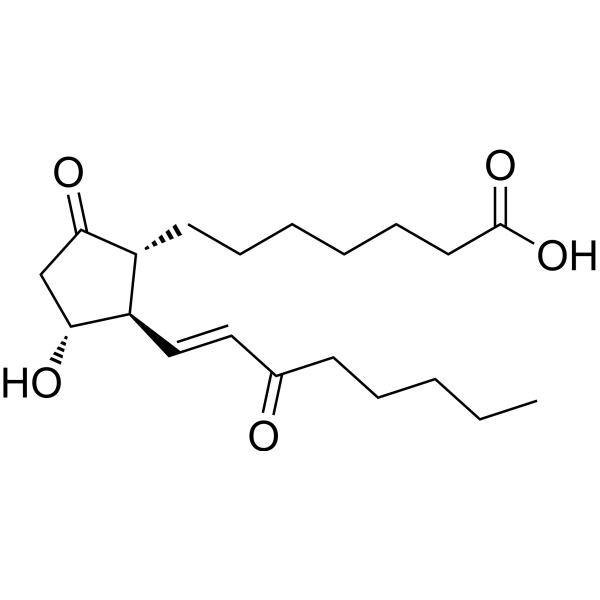
-
- HY-149502
-
|
8-Iso(15R)PGF2α; 15(R)-8-Iso-PGF2α
|
Prostaglandin Receptor
|
Metabolic Disease
|
|
8-Iso-15(R)-prostaglandin F2α (8-Iso(15R)PGF2α), a type of eicosanoid, is a oxidized metabolite of Prostaglandin F2α (PGF2α) .
|
-

-
- HY-113246
-
|
15-keto-PGF2α
|
Prostaglandin Receptor
Endogenous Metabolite
|
Endocrinology
|
|
15-keto-Prostaglandin F2α (15-keto-PGF2α) is a metabolite of Prostaglandin F2α. Prostaglandin F2α. Prostaglandin F2α is an orally active, potent prostaglandin F (PGF) receptor (FP receptor) agonist and plays a key role in the onset and progression of labour .
|
-
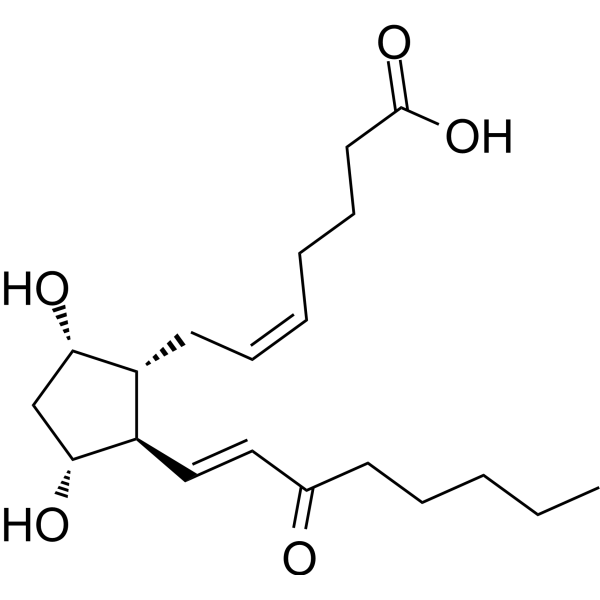
-
- HY-109545
-
|
Unoprostone isopropyl ester; UF-021
|
Potassium Channel
|
Others
|
|
Isopropyl unoprostone (Unoprostone isopropyl ester), an analogue of a prostaglandin metabolite, is a potent large conductance Ca 2+-activated K + (BK) channels activator. Isopropyl unoprostone has antiglaucoma effects, lowering intraocular pressure (IOP) by increasing aqueous humour outflow. Isopropyl unoprostone can improve retinal sensitivity and the protection of central retinal sensitivity .
|
-
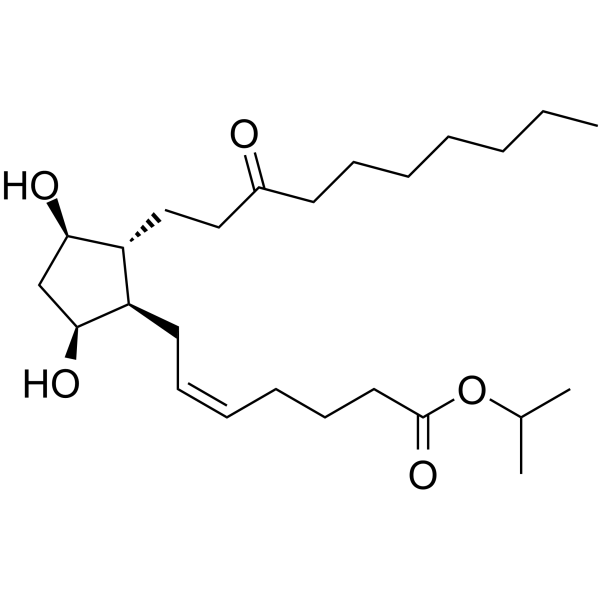
-
- HY-113366
-
|
PGJ2
|
Prostaglandin Receptor
Endogenous Metabolite
|
Neurological Disease
|
|
Prostaglandin J2 (PGJ2), an endogenous metabolite of Prostaglandin D2 (PGD2; HY-101988), is a potent PGD2 receptor (DP) agonist with Kis of 0.9 nM and 6.6 nM for hDP and hCRTH2, respectively. Prostaglandin J2 stimulates intracellular cyclic AMP production with an EC50 value of 1.2 nM. Prostaglandin J2 induces oxidative stress and neuronal apoptosis. Prostaglandin J2 induces the accumulation/aggregation of ubiquitinated (Ub) proteins. Prostaglandin J2 is highly neurotoxic and potentially contributes to many neurodegenerative conditions, including Alzheimer's (AD) and Parkinson's diseases (PD) .
|
-
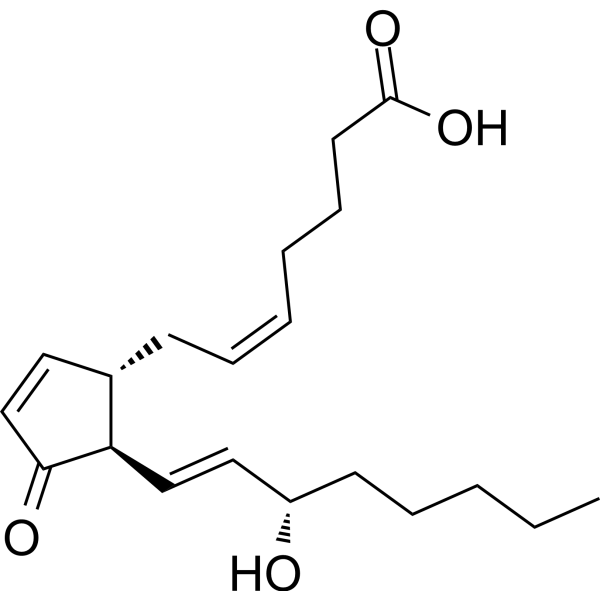
-
- HY-120665
-
-

-
- HY-126819
-
|
PGH1
|
Prostaglandin Receptor
|
Inflammation/Immunology
|
|
Prostaglandin H1 (PGH1), the cyclooxygenase metabolite of DGLA, is also a CRTh2 agonist and precursor for the anti-inflammatory prostaglandins of the 1-series. Prostaglandin H1 can be used in the study of inflammation .
|
-
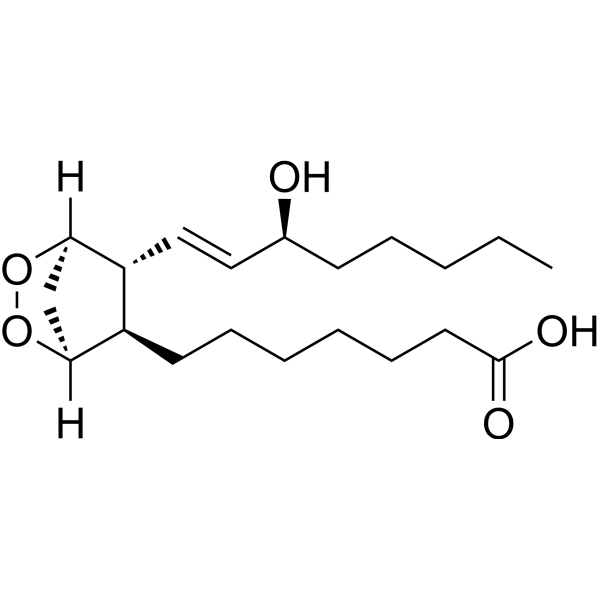
-
- HY-126986
-
-
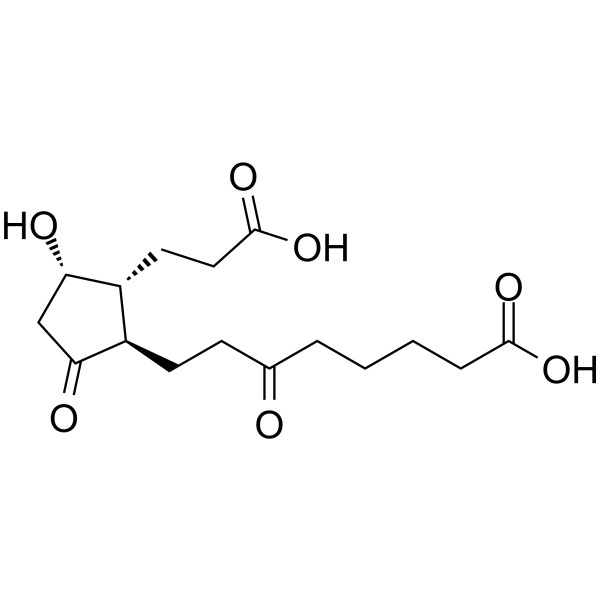
-
- HY-157976
-
|
dinor-PGE1
|
Endogenous Metabolite
Prostaglandin Receptor
|
Others
|
|
Dinorprostaglandin E1 (dinor-PGE1) is the hepatocyte metabolite of prostaglandin E1 and prostaglandin E. Prostaglandin E1 and prostaglandin E inhibit glucagon, epinephrine, isoproterenol (beta-adrenergic agonist), or epinephrine-stimulated glycogenolysis when co-treated with Isoproterenol (HY-B0468) .
|
-
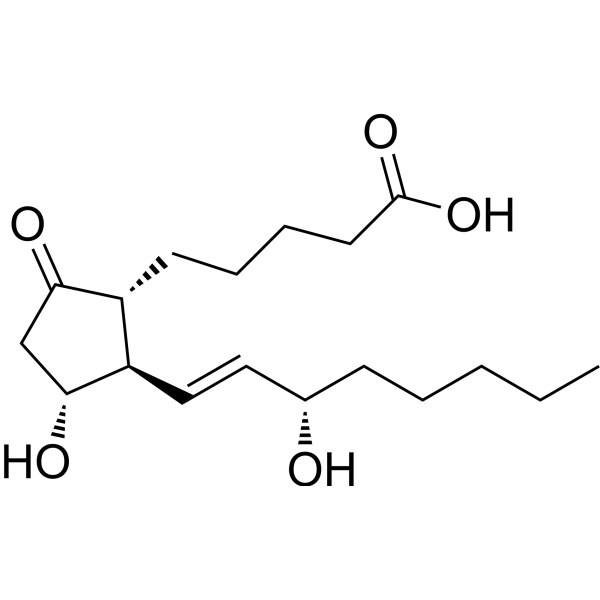
-
- HY-113041
-
|
PGA2; Medullin
|
Endogenous Metabolite
Apoptosis
|
Infection
Cancer
|
|
Prostaglandin A2 (PGA2), a human endogenous metabolite of PGE2, is an antitumor agent. Prostaglandin A2 induces p53-dependent apoptosis. Prostaglandin A2 also has antiviral activity .
|
-

-
- HY-116083
-
|
|
Endogenous Metabolite
|
Others
|
|
13,14-Dihydro-15-keto-tetranor prostaglandin D2 (Compound VI) is a prostaglandin D2 metabolite. 13,14-Dihydro-15-keto-tetranor prostaglandin D2 as a biomarker can be used to study prostaglandin D2-related diseases .
|
-

-
- HY-131729
-
|
|
Others
|
Cardiovascular Disease
|
|
16-Phenoxy tetranor Prostaglandin A2 is a metabolite of uprostone and an analog of the antifertility hormone PGF2α .
|
-
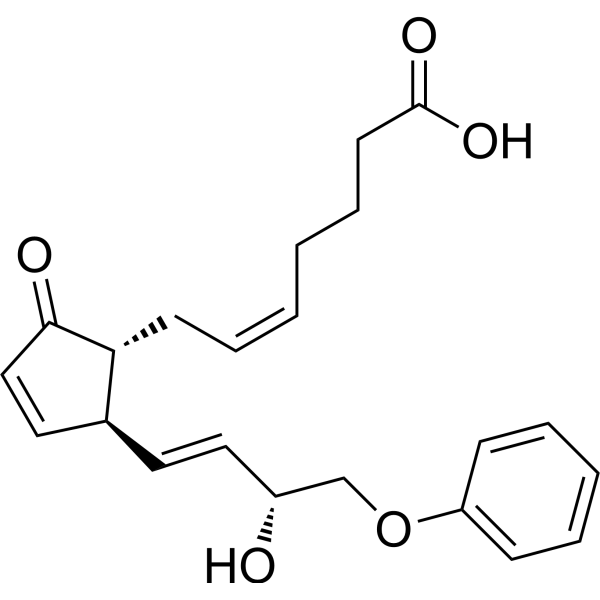
-
- HY-129764A
-
|
17-trans-PGF3α
|
Others
|
Inflammation/Immunology
|
|
(17E)-Prostaglandin F3α (17-trans-PGF3α) is a double bond isomer of Prostaglandin F3α (HY-129764) and a potential metabolite of trans dietary fatty acids. (17E)-Prostaglandin F3α has anti-inflammatory activity .
|
-
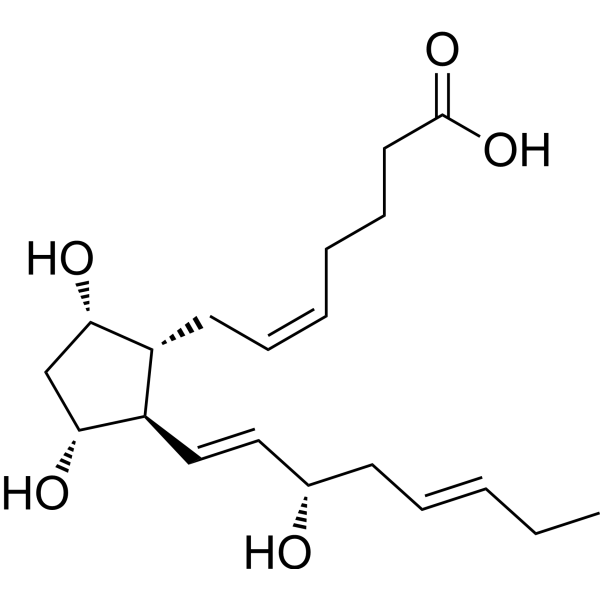
-
- HY-129953B
-
|
15-epi PGF2α; 15(R)-PGF2α
|
Endogenous Metabolite
|
Inflammation/Immunology
|
|
15(R)-Prostaglandin F2α is the isomer of 9α,11β-Prostaglandin F2α (HY-129953). 9α,11β-Prostaglandin F2α is an endogenous metabolite present in Urine that can be used for the research of Asthma .
|
-

-
- HY-108568
-
|
15d-PGJ2; 15-Deoxy-Δ12,14-PGJ2
|
PPAR
Endogenous Metabolite
|
Neurological Disease
Inflammation/Immunology
Cancer
|
|
15-Deoxy-Δ-12,14-prostaglandin J2 (15d-PGJ2) is a cyclopentenone prostaglandin and a metabolite of PGD2. 15-Deoxy-Δ-12,14-prostaglandin J2 is a selective PPARγ (EC50 of 2 µM) and a covalent PPARδ agonist. 15-Deoxy-Δ-12,14-prostaglandin J2 promotes efficient differentiation of C3H10T1/2 fibroblasts to adipocytes with an EC50 of 7 μM .
|
-
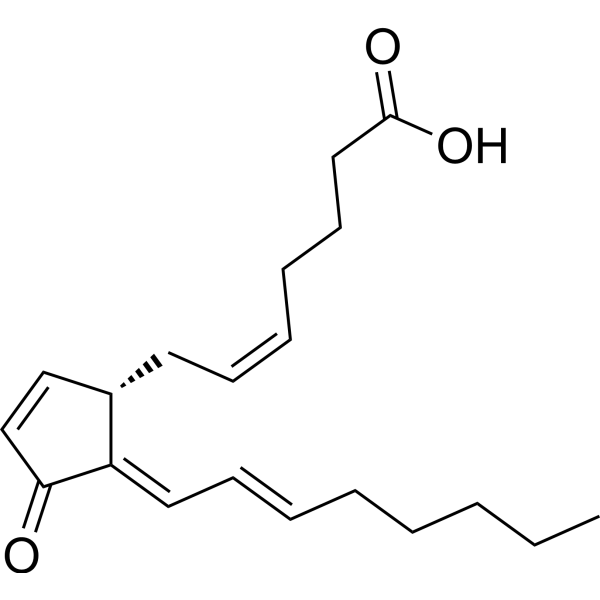
-
- HY-108568S
-
|
15d-PGJ2-d4; 15-Deoxy-Δ12,14-PGJ2-d4
|
PPAR
Endogenous Metabolite
|
Neurological Disease
Inflammation/Immunology
Cancer
|
|
15-Deoxy-Δ-12,14-prostaglandin J2-d4 is the deuterium labeled 15-Deoxy-Δ-12,14-prostaglandin J2. 15-Deoxy-Δ-12,14-prostaglandin J2 (15d-PGJ2) is a cyclopentenone prostaglandin and a metabolite of PGD2. 15-Deoxy-Δ-12,14-prostaglandin J2 is a selective PPARγ (EC50 of 2 µM) and a covalent PPARδ agonist. 15-Deoxy-Δ-12,14-prostaglandin J2 promotes efficient differentiation of C3H10T1/2 fibroblasts to adipocytes with an EC50 of 7 μM[1][2].
|
-

-
- HY-113205
-
|
15-keto-PGE2
|
Endogenous Metabolite
Prostaglandin Receptor
STAT
PPAR
|
Cancer
|
|
15-keto-Prostaglandin E2 is an endogenous metabolite. 15-keto-Prostaglandin E2 inhibits STAT3 activation by binding to its Cys259 residue. 15-keto-Prostaglandin E2 can bind and stabilize EP2 and EP4 receptor. 15-keto-Prostaglandin E2 inhibits breast cancer cell growth and progression. 15-keto-Prostaglandin E2 activates PPAR-γ and promotes fungal growth .
|
-
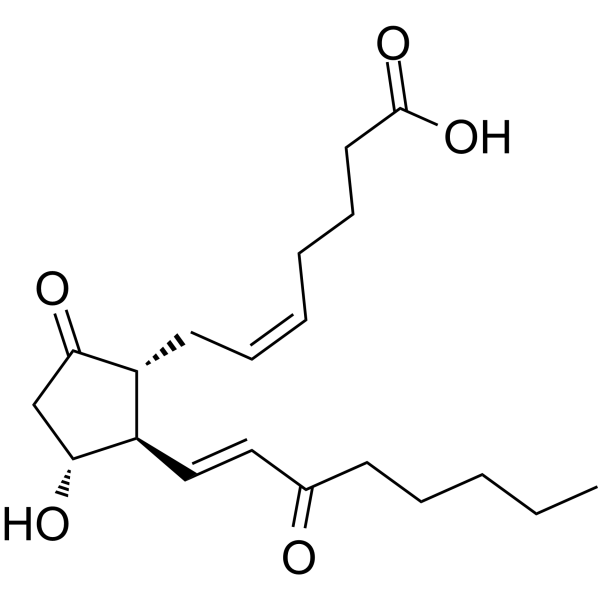
-
- HY-129953A
-
-

-
- HY-114687
-
|
|
Others
|
Others
|
|
5,7-Dihydroxy-11-ketotetranorprostanoic acid is a urinary metabolite of prostaglandin F2α and precursor to tetranor-PGF metabolites, exhibits hardly activity in blood pressure assay and smooth muscle stiumulation assay .
|
-

-
- HY-125607
-
-
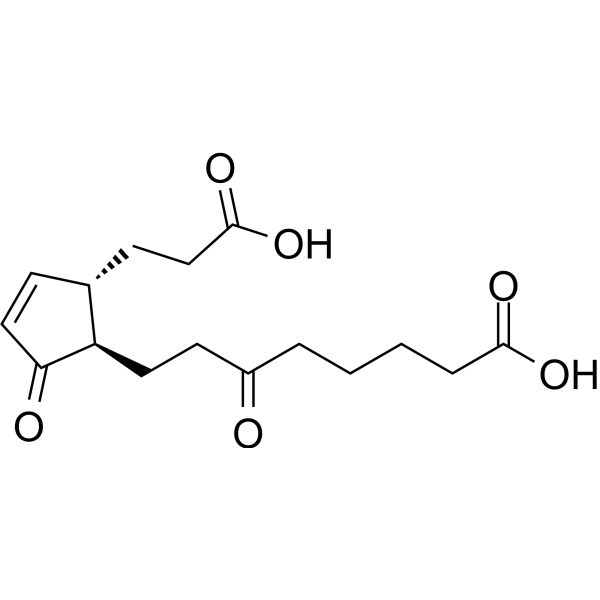
-
- HY-139199
-
|
|
Drug Metabolite
|
Others
|
|
4-Hydroxyphenylbutazone is a metabolite of Phenylbutazone. Phenylbutazone, a nonsteroidal anti-inflammatory agent (NSAID), is an efficient reducing cofactor for the peroxidase activity of prostaglandin H synthase (PHS) .
|
-

-
- HY-129953
-
-
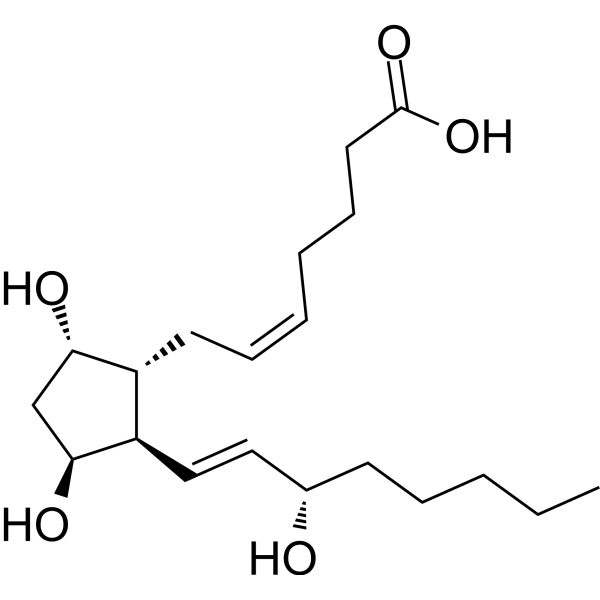
-
- HY-117431
-
|
PGB3
|
PPAR
Endogenous Metabolite
|
Metabolic Disease
|
|
Prostaglandin B3 (PGB3) is a member of the class of prostaglandins B and a secondary alcohol. PGB3 exhibits a rather low affinity to human PPARγ with a Ki value greater than 1 mM compared with Ki values of 26.28 ± 8.7 μM for PGB1 and 77 ± 37.7 μM for PGB2 .
|
-

-
- HY-137270
-
|
16,16-Dimethyl prostaglandin A2; Di-M-PGA2
|
Endogenous Metabolite
|
Endocrinology
Cancer
|
|
16,16-Dimethyl PGA2 is an orally active prostaglandin analog with a prolonged in vivo half-life. 16,16-Dimethyl PGA2 can be used to study hypertension .
|
-

-
- HY-118830
-
|
DK-PGD2; 15-Oxo-13,14-dihydro-PGD2; 13,14-Dihydro-15-keto-PGD2
|
Prostaglandin Receptor
|
Endocrinology
|
|
13, 14-Dihydro-15-keto prostaglandin D2 (DK-PGD2) is a PGD2 metabolite formed by the 15-hydroxyl PGDH pathway. 13, 14-Dihydro-15-keto prostaglandin D2 is a selective agonist for the DP2 receptor. 13, 14-Dihydro-15-keto prostaglandin D2 can inhibit ion flux in canine colonic mucosa preparation .
|
-
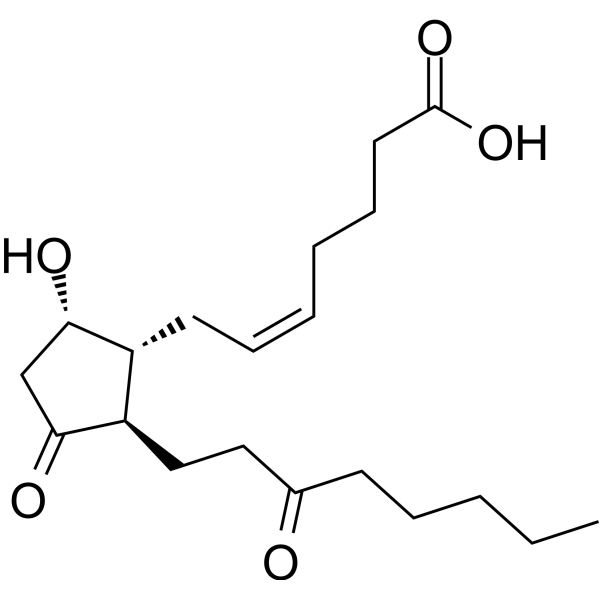
-
- HY-118548
-
|
|
Drug Metabolite
|
Endocrinology
|
|
Tetranor-PGAM is a tetranor-prostaglandin A metabolite. Tetranor-PGAM is a dehydration product of tetranor-PGEM (HY-114988). Tetranor-PGAM can be measured as a surrogate for tetranor-PGEM levels in urine .
|
-
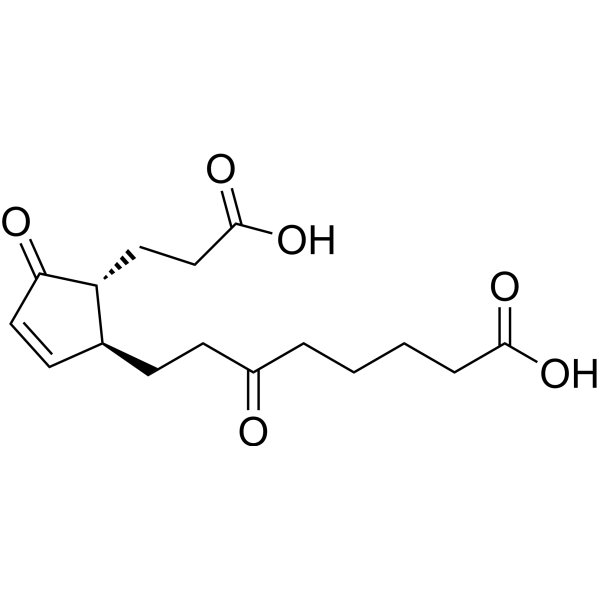
-
- HY-113358
-
|
|
Endogenous Metabolite
|
Inflammation/Immunology
|
|
6-keto Prostaglandin F1α is an endogenous metabolite present in Cerebrospinal_Fluid, Urine and Blood that can be used for the research of Meningitis, Rheumatoid Arthritis and Cardiopulmonary Resuscitation .
|
-
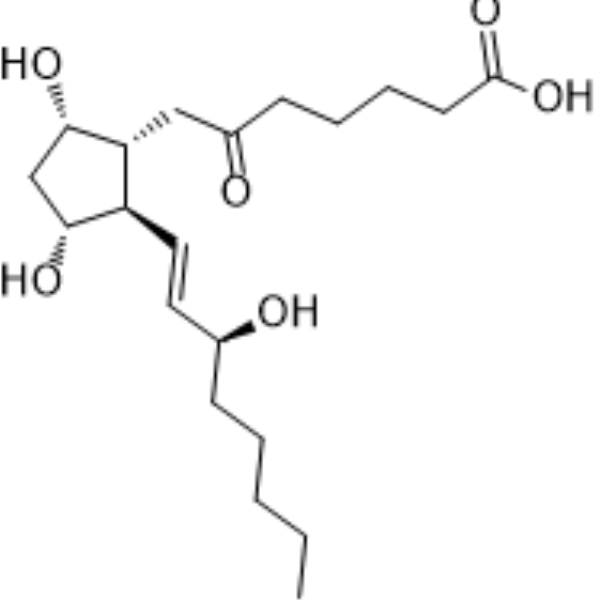
-
- HY-12956B
-
|
prostaglandin F2β; PGF2β
|
Endogenous Metabolite
|
Others
|
|
(5R)-Dinoprost is a metabolite produced by cyclooxygenase metabolism of arachidonic acid. (5R)-Dinoprost (Prostaglandin F2β) induces dose-dependent release of hexose containing mucin .
|
-

-
- HY-113113
-
|
13,14-Dihydroprostaglandin E1
|
Endogenous Metabolite
|
Metabolic Disease
|
|
13,14-Dihydro PGE1 is a metabolite of PGE1 (Prostaglandin E1) which inhibits the ADP-induced platelet aggregation (ID50 = 10.8 ng/mL platelet rich plasma) .
|
-
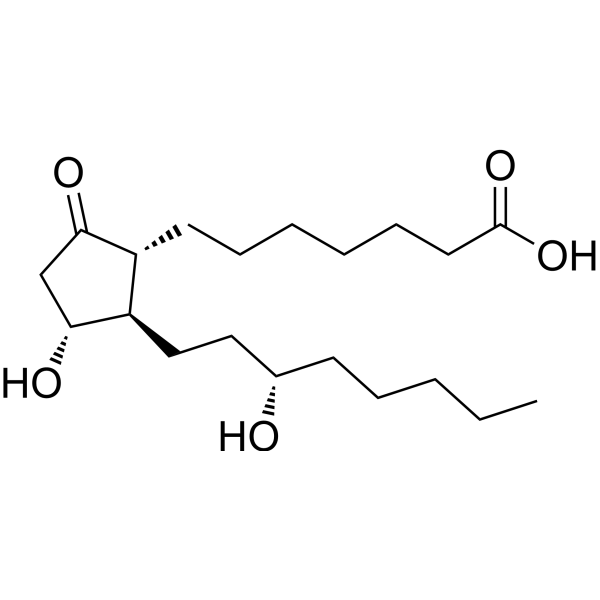
-
- HY-114850A
-
|
prostaglandin F2β tromethamine; PGF2β tromethamine
|
Endogenous Metabolite
|
Others
|
|
(5R)-Dinoprost tromethamine (Prostaglandin F2β tromethamine) is a metabolite produced by the metabolism of arachidonic acid cyclooxygenase. (5R)-Dinoprost tromethamine induces dose-dependent release of hexosaccharide containing mucin .
|
-
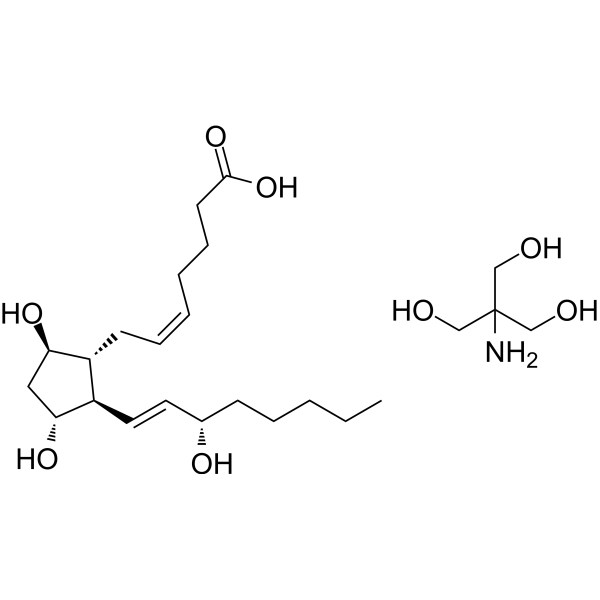
-
- HY-137024
-
|
|
Others
|
Cardiovascular Disease
|
|
15-Keto-PGA1 is a metabolite of PGA1 and has significant vasoconstrictive effects. PGA1 is also a vasoconstrictor and is more potent than equivalent doses of prostaglandin F2α (PGF2α) and angiotensin II .
|
-

-
- HY-114988
-
|
tetranor-PGEM
|
Endogenous Metabolite
|
Inflammation/Immunology
Cancer
|
|
PGE-M is a metabolite of prostaglandin E2 (PEG2) as a biomarker of inflammation and cancer including advanced colorectal neoplasia, ovarian cancer, prostate cancer and so on. Urinary PGE-M is positively associated with obesity, smoking and lung metastases with breast cancer .
|
-
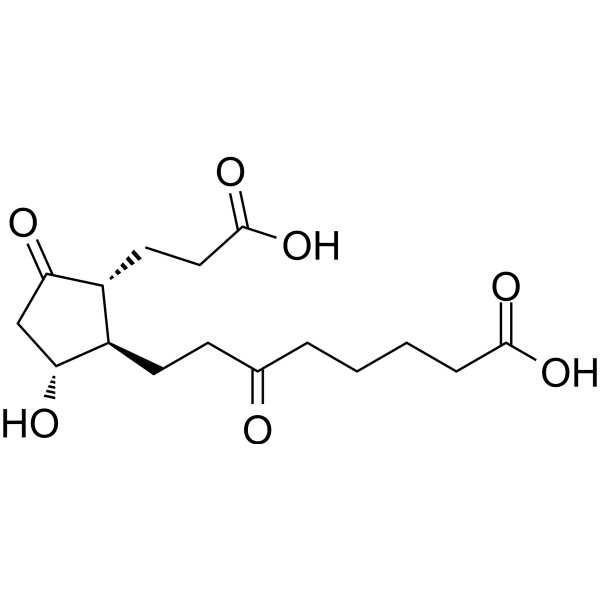
-
- HY-129397
-
|
BPG; 2,3-Dinor-11β-PGF2α; 2,3-dinor-11-epi PGF2α
|
Prostaglandin Receptor
|
Endocrinology
|
|
2,3-Dinor-11beta-prostaglandin F2alpha (2,3-Dinor-11β-PGF2α) is a metabolite of PGD2. Urinary excretion of 2,3-Dinor-11beta-prostaglandin F2alpha is increased in patients with mast cell activation disease (MCAD) and has been used as a marker of increased PGD2 levels. 2,3-Dinor-11beta-prostaglandin F2alpha levels are also increased in the urine of patients with asthma and are positively correlated with impaired lung function.
|
-

-
- HY-157925
-
|
Bicyclo prostaglandin E1
|
Others
|
Others
|
|
Bicyclo-PGE1 (Bicyclo Prostaglandin E1) is a stable, base-catalyzed transformation product of the PGE1 metabolite 13,14-dihydro-15-keto PGE1. Bicyclo-PGE1 can be used to estimate the biosynthesis and metabolism of PGE1 in vivo .
|
-
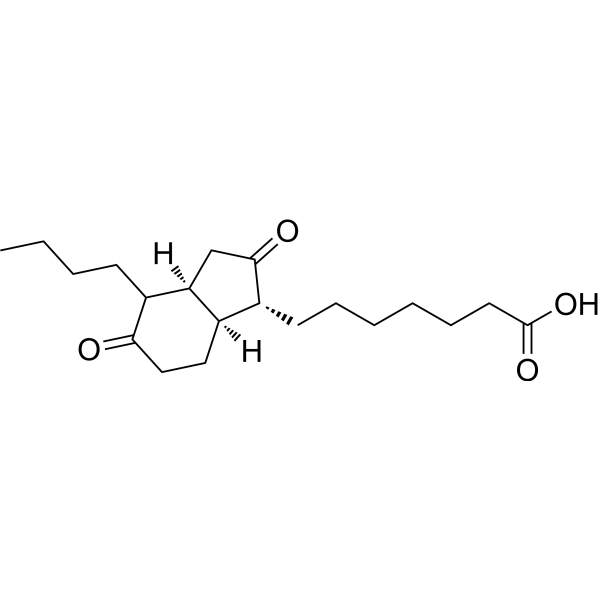
-
- HY-116591
-
|
|
Others
|
Endocrinology
|
|
8-ISo-15-keto prostaglandin F2β is a potential metabolite of 8-Iso PGF2β via the 15-hydroxy-PG dehydrogenase pathway. 8-iso PGF2β constricts pulmonary veins in dogs and pigs .
|
-

-
- HY-113208A
-
|
11β-13,14-Dihydro-15-keto PGF2α; 11-epi-13,14-dihydro-15-keto PGF2α
|
Endogenous Metabolite
|
Others
|
|
11β-13,14-Dihydro-15-keto Prostaglandin F2α is the deviative of 13,14-Dihydro-15-keto PGF2a (HY-113208), which is an endogenous metabolite present in Blood that can be used for the research of Pregnancy .
|
-

-
- HY-N7857
-
|
19(R)-Hydroxy PGF2α
|
Others
|
Metabolic Disease
|
|
19(R)-Hydroxy-prostaglandin F2α (19(R)-hydroxy PGF2α) is an ω-1 hydroxylase metabolite of PGF2α found in human semen. The concentration of 19(R)-Hydroxy-PGFs compounds (F2α and F1α together) in fresh human semen is about 20 μg/mL. 19(R)-Hydroxy-prostaglandin F2α exhibits no activity at the FP receptor of the cat iris sphincter muscle at concentrations up to 1 μM.
|
-

-
- HY-118189
-
|
|
Prostaglandin Receptor
|
Inflammation/Immunology
|
|
Misoprostol acid is an active metabolite of Misoprostol. Misoprostol is a synthetic analogue of prostaglandin E1 (PGE1), extensively absorbed, and undergoes rapid de-esterification to Misoprostol acid in the gastrointestinal tract after oral administration. Misoprostol can be used for non-steroidal anti-inflammatory drug-induced (NSAID) gastric ulcers . Misoprostol is an oral agent used to induce labor .
|
-
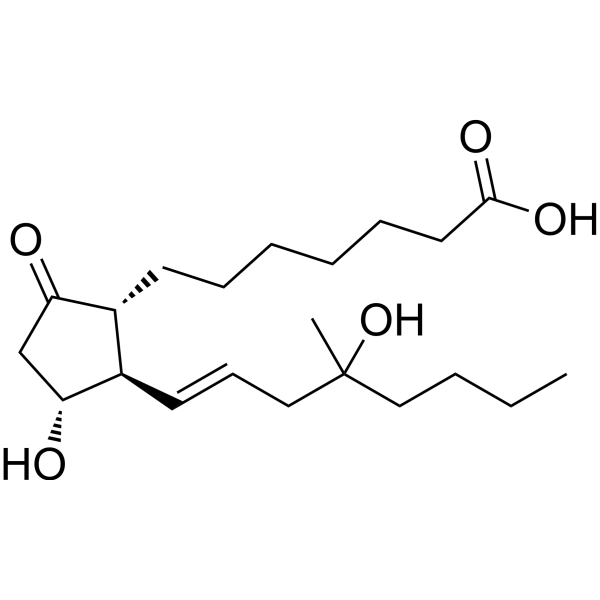
-
- HY-N4237
-
|
|
Prostaglandin Receptor
Potassium Channel
|
Inflammation/Immunology
|
|
Saikogenin D is isolated from Bupleurum chinense, has anti-inflammatory effects. Saikogenin D activates epoxygenases that converts arachidonic acid to epoxyeicosanoids and dihydroxyeicosatrienoic acids, and the metabolites secondarily inhibit prostaglandin E2 (PGE2) production. Saikogenin D results in an elevation of [Ca 2+]i due to Ca 2+ release from intracellular stores .
|
-
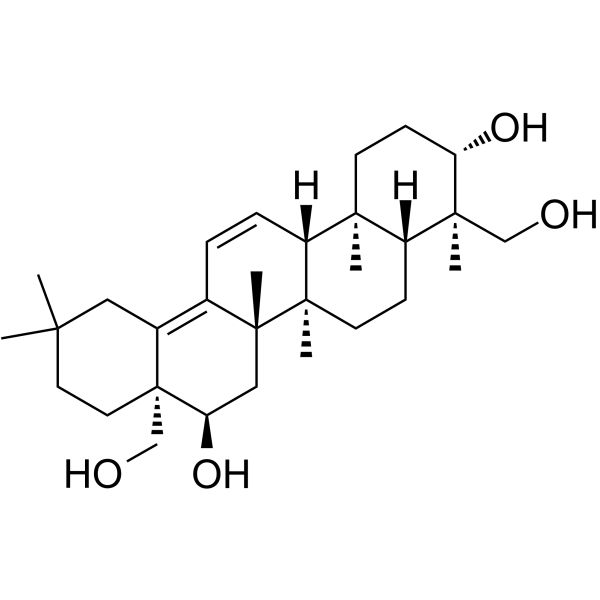
-
- HY-101813
-
|
HR325
|
Dihydroorotate Dehydrogenase
DNA/RNA Synthesis
Prostaglandin Receptor
|
Inflammation/Immunology
|
|
Laflunimus (HR325) is an immunosuppressive agent and an analogue of the Leflunomide-active metabolite A77 1726. Laflunimus is an orally active inhibitor of dihydroorotate dehydrogenase (DHODH). Laflunimus suppresses immunoglobulin (Ig) secretion, with IC50 values of 2.5 and 2 µM for IgM and IgG, respectively. Laflunimus also is a prostaglandin endoperoxide H synthase (PGHS) -1 and -2 inhibitor .
|
-
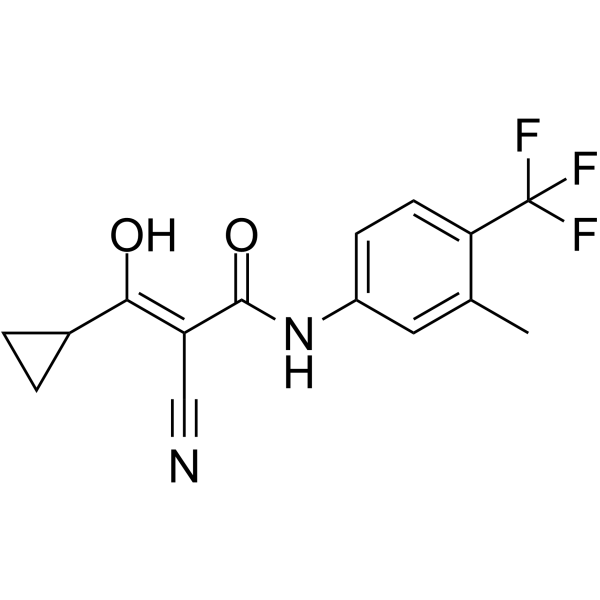
-
- HY-118189S
-
|
|
Isotope-Labeled Compounds
Prostaglandin Receptor
|
Inflammation/Immunology
|
|
Misoprostol acid-d5 is deuterium labeled Misoprostol acid. Misoprostol acid is an active metabolite of Misoprostol. Misoprostol is a synthetic analogue of prostaglandin E1 (PGE1), extensively absorbed, and undergoes rapid de-esterification to Misoprostol acid in the gastrointestinal tract after oral administration. Misoprostol can be used for non-steroidal anti-inflammatory drug-induced (NSAID) gastric ulcers[1]. Misoprostol is an oral agent used to induce labor[2].
|
-

-
- HY-W740572
-
|
|
Others
|
Inflammation/Immunology
|
|
O-Desmethyl-N-deschlorobenzoyl indomethacin is a metabolite of the non-steroidal anti-inflammatory drug (NSAID) and COX inhibitor indomethacin (HY-14397). It is formed from indomethacin in isolated rabbit hepatocytes. O-Desmethyl-N-deschlorobenzoyl indomethacin (600 μM) decreases the viability of HL-60 leukemia cells when cultured with glucose oxidase. It has also been used in the synthesis of prostaglandin D2 (HY-101988) receptor antagonists.
|
-

-
- HY-116889
-
|
|
Drug Metabolite
|
Others
|
|
15-keto Latanoprost is a potential metabolite of latanoprost (HY-B0577) when administered to animals. 15-keto Latanoprost is also one of the common minor impurities found in commercial preparations of the bulk drug compound. Although much less potent that the parent compound latanoprost, 15-keto latanoprost still retains the ability to produce a small but measurable decrease (1 mm Hg) in the intraocular pressure of normal cynomolgus monkeys when administered at a dose of 1 μg/eye.1 15-keto Latanoprost is also a miotic in the normal cat eye, causing an 8 mm Hg reduction in pupillary diameter at 5 μg/eye. Again, this is not as potent as many other F-type prostaglandins; for example, prostaglandin F2α will produce this degree of miosis at a dose of less than 1 μg/eye.
|
-

-
- HY-137547
-
|
20-Hydroxy PGF2α
|
Prostaglandin Receptor
|
Metabolic Disease
|
|
20-hydroxy Prostaglandin F2α (20-hydroxy PGF2α) is the ω-oxidation product of PGF2α. Cultured type II alveolar cells from pregnant rabbits metabolize exogenous PGF2α via microsomal cytochrome P450 ω-oxidation, producing 20-hydroxy PGF2α and its 15-hydroxy PGDH metabolites. Cells from male rabbits exhibit only the 15-hydroxy PGDH pathway.
|
-

-
- HY-118816
-
|
11-epi PGF2α-EA; 11β-PGF2α-EA; 11β-Prostamide F2α
|
Others
|
Metabolic Disease
|
|
11β-Prostaglandin F2α ethanolamide (11β-PGF2α-EA) is the theoretical hepatic metabolite of PGD2-EA, produced during COX-2 metabolism of the endogenous cannabinoid AEA which is found in brain, liver, and other mammalian tissues.1 AEA can be used directly by COX-2 and specific PG synthase to produce ethanolamide congeners of the classical PGs. PGD2-EA is formed in activated RAW 264.7 cells treated with AEA.
|
-

-
- HY-139121
-
|
15-epi Bimatoprost free acid; 15(R)-Bimatoprost free acid; 15(R)-17-phenyl trinor PGF2α
|
Prostaglandin Receptor
|
Endocrinology
|
|
17-phenyl trinor Prostaglandin F2α (17-phenyl trinor PGF2α) N-ethyl amide is an F-series prostaglandin analog which has been approved for use as an ocular hypotensive agent. Investigations in our lab have shown that 17-phenyl trinor PGF2α ethyl amide is converted by an amidase enzymatic activity in the human cornea to yield the corresponding free acid, with a conversion rate of about 25 μg/cornea/24 hr. The free acid, 17-phenyl trinor PGF2α, is a potent FP receptor agonist. 15(R)-17-phenyl trinor PGF2α is the 15-epi, or “unnatural” isomer of this active free acid metabolite. It has much diminished FP receptor-mediated activity, which is generally 1.5 to 2 logs less than the 15(S)-isomer. In human and animal models of glaucoma, FP receptor agonist activity corresponds very closely with intraocular hypotensive activity.
|
-

-
- HY-113778
-
|
15-keto-17-phenyl trinor PGF2α
|
Prostaglandin Receptor
|
Endocrinology
|
|
Bimatoprost is an F-series prostaglandin (PG) analog which has been approved for use as an ocular hypotensive drug.1 Oxidation of the C-15 hydroxyl group and amide hydrolysis of Bimatoprost produces 15-keto-17-phenyl trinor PGF2α. 15-keto-17-phenyl trinor PGF2α is a potential metabolite of bimatoprost when administered to animals. 15-keto PG analogs are potential minor impurities in commercial preparations of their corresponding bulk drug compounds. Although much less potent that the parent compound, 15-keto PGs still retain the ability to produce a small but measurable decrease (1 mm Hg) in the intraocular pressure of normal cynomolgus monkeys when administered at a dose of 1 μg/eye.2 15-keto Latanoprost (15-keto-17-phenyl-13,14-dihydro trinor PGF2α isopropyl ester) is a miotic in the normal cat eye, causing an 8 mm reduction in pupillary diameter at 5 μg/eye. Again, this is not as potent as many other F-type PGs; for example, PGF2α will produce this degree of miosis at a dose of less than 1 μg/eye.
|
-

| Cat. No. |
Product Name |
Category |
Target |
Chemical Structure |
| Cat. No. |
Product Name |
Chemical Structure |
-
- HY-108568S
-
|
|
|
15-Deoxy-Δ-12,14-prostaglandin J2-d4 is the deuterium labeled 15-Deoxy-Δ-12,14-prostaglandin J2. 15-Deoxy-Δ-12,14-prostaglandin J2 (15d-PGJ2) is a cyclopentenone prostaglandin and a metabolite of PGD2. 15-Deoxy-Δ-12,14-prostaglandin J2 is a selective PPARγ (EC50 of 2 µM) and a covalent PPARδ agonist. 15-Deoxy-Δ-12,14-prostaglandin J2 promotes efficient differentiation of C3H10T1/2 fibroblasts to adipocytes with an EC50 of 7 μM[1][2].
|
-

-
- HY-118189S
-
|
|
|
Misoprostol acid-d5 is deuterium labeled Misoprostol acid. Misoprostol acid is an active metabolite of Misoprostol. Misoprostol is a synthetic analogue of prostaglandin E1 (PGE1), extensively absorbed, and undergoes rapid de-esterification to Misoprostol acid in the gastrointestinal tract after oral administration. Misoprostol can be used for non-steroidal anti-inflammatory drug-induced (NSAID) gastric ulcers[1]. Misoprostol is an oral agent used to induce labor[2].
|
-

Your information is safe with us. * Required Fields.
Inquiry Information
- Product Name:
- Cat. No.:
- Quantity:
- MCE Japan Authorized Agent:

























































